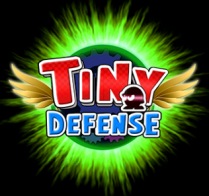 The Little Ones Strike Back
The Little Ones Strike Back
Some big robots have started bulldozing the home world of some little robots, hoping to turn it into a resort for space-faring tourists. Never mind the question of how a planet came to be populated by indigenous robots without intervening humans anywhere in sight, you’ve got a Tiny Defense (Out Now, $2.99) to direct!
Tiny Defense isn’t one of those games that reaches out and grabs you from the start. Maybe it would have been a year or two ago, but its Castle Defense formula feels so by-the-book that it doesn’t stand out at first blush within such a well saturated genre. As expected, the player begins each battle with an empty playing field, dispatching some resource-generating bots and figuring out which units to recruit with the gems these workhorses pump out. The game revolves around a fairly strict rock-paper-scissors regime. The standard issue Gunner Bot can strike enemies on the ground but can’t do anything when it comes to airborne foes; a balanced defense force will back these up with Cannon Bots that can fire into the sky. There’s no castle per se — only a Heart meter that’s whittled down as enemies make it past the defensive gauntlet.
 The first noticeable element that sets Tiny Defense apart from the crowd doesn’t necessarily work to its advantage, either. Once the player’s drag-and-dropped units onto a 2D position grid, the units are locked in place until they’re trashed by enemies — a far cry from the extra layer of strategy genre fans have enjoyed in games where maneuver plays a key role. Over time, however, I came to appreciate the nuance in Tiny Defense’s battlefield landscaping, which makes the player carefully consider how units should be spread over the limited land and air space. Tiny Defense also does a downright outstanding job of stirring in content at a measured pace, keeping quirky new units flowing into the player’s repertoire throughout. Action-oriented minigames pop up at regular intervals and toss out the resource management aspect entirely, keeping the player’s experience nicely varied.
The first noticeable element that sets Tiny Defense apart from the crowd doesn’t necessarily work to its advantage, either. Once the player’s drag-and-dropped units onto a 2D position grid, the units are locked in place until they’re trashed by enemies — a far cry from the extra layer of strategy genre fans have enjoyed in games where maneuver plays a key role. Over time, however, I came to appreciate the nuance in Tiny Defense’s battlefield landscaping, which makes the player carefully consider how units should be spread over the limited land and air space. Tiny Defense also does a downright outstanding job of stirring in content at a measured pace, keeping quirky new units flowing into the player’s repertoire throughout. Action-oriented minigames pop up at regular intervals and toss out the resource management aspect entirely, keeping the player’s experience nicely varied.
Tiny Defense is definitely on the easier side of average for this genre, so the Castle Defense veteran may want to handicap him-or-herself by skipping opportunities to upgrade starting resources and unit capacity. Once I unlocked the bestiary and had a chance to flip through it, I was amazed to find genuinely witty descriptions for each of the game’s hero units and enemies. Nor do I have any complaints with Tiny Defense’s interface; the player may not get much of an opportunity to orchestrate exciting battlefield maneuvers, but at least everything else functions perfectly.
 One thing genre fans will find off-putting at first is that the player can’t pan the battlefield — it’s a single screen that doesn’t afford much of a visual of incoming foes aside from a starting peek at the enemy lineup. On balance, Tiny Defense turns this around by pulling off something really interesting on the aesthetic side: the player does hear foes well before they emerge. Therefore careful attention to the sound effects pouring through one’s earbuds is important in building a maximally efficient defense — obviously a major gameplay disadvantage for the hearing impaired, so fair warning.
One thing genre fans will find off-putting at first is that the player can’t pan the battlefield — it’s a single screen that doesn’t afford much of a visual of incoming foes aside from a starting peek at the enemy lineup. On balance, Tiny Defense turns this around by pulling off something really interesting on the aesthetic side: the player does hear foes well before they emerge. Therefore careful attention to the sound effects pouring through one’s earbuds is important in building a maximally efficient defense — obviously a major gameplay disadvantage for the hearing impaired, so fair warning.
Packing in 50 levels – not counting minigames – and 40 units, Tiny Defense promises three to four hours of solid strategic entertainment for those who become interested enough to stick with it.
iFanzine Verdict: Its by-the-book formula underwhelms at first blush, but Tiny Defense should prove surprisingly interesting to genre fans who give it a chance and stick with it past the first few levels. This is due entirely to the way the developer keeps new content flowing in; it seems that no matter how far you dive in, there’s always some new gameplay element to look forward to.
[xrr rating=4/5]


